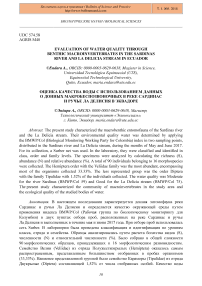Evaluation of water quality through benthic macroinvertebrates in the Sardinas river and La Delicia stream in Ecuador
Автор: Endara Alexandra
Журнал: Бюллетень науки и практики @bulletennauki
Рубрика: Биологические науки
Статья в выпуске: 8 т.4, 2018 года.
Бесплатный доступ
The present study characterized the macrobenthic entomofauna of the Sardinas river and the La Delicia stream. Their environmental quality water was determined by applying the BMWP/Col (Biological Monitoring Working Party for Colombia) index in two sampling points, distributed in the Sardinas river and La Delicia stream, during the months of May and June 2017. For its collection, a Surber net was used. In the laboratory, they were classified and identified in class, order and family levels. The specimens were analyzed by calculating the richness (S), abundance (N) and relative abundance (%). A total of 90 individuals belonging to 16 morphospecies were collected. The Hemiptera order with the Veliidae family was the most abundant, encompassing most of the organisms collected 33.33%. The less represented group was the order Diptera with the family Tipulidae with 1.52% of the individuals collected. The water quality was Moderate for the river Sardinas (BMWP/Col 59) and Good for the La Delicia stream (BMWP/Col 75). The present study characterized the community of macroinvertebrates in the study area and the ecological quality of the studied bodies of water.
Aquatic entomofauna, environmental quality, richness and abundance
Короткий адрес: https://sciup.org/14112205
IDR: 14112205 | УДК: 574.58 | DOI: 10.5281/zenodo.1345106
Список литературы Evaluation of water quality through benthic macroinvertebrates in the Sardinas river and La Delicia stream in Ecuador
- Courtemach D., Davies L., Laverty E. B. Incorporation of biological information in water quality planning//Environmental Management. 1989. №13. P. 35-41.
- Figueroa R., Araya E., Parra O., Valdovinos C. Macroinvertebrados bentónicos como indicadores de calidad de agua//Resúmenes Sexta Jornada del Comité Chileno para el Programa Hidrológico internacional. 1999. P. 1-24.
- Paz y Miño S. Centro para el desarrollo turístico de Pacto "CEPADET"//Universidad de especialidades Turísticas U.C.T. Tesis de Pregrado, 2005. P. 10-12.
- Gobierno Autónomo Descentralizado Rural de Pacto//Plan de Ordenamiento Territorial de Pacto, Elecciones. Pacto, Ecuador, 2012. P. 1-10.
- Gentry A. Patterns of diversity and floristic composition in neotropical montane forest//S. Churchill (ed.). Biodiversity and conservation of neotropical montane forest. New York: New York Botanical Garden, 1995. P. 103-126.
- Borchsenius F. Patterns of plant species endemism in Ecuador//Biodiversity and Conservation. 1997. №6. P. 379-399.
- Mittermeier R., Myers N., Robles-Gil P., Goettsch-Mittermeier C. Biodiversidad amenazada. Las ecorregiones terrestres prioritarias del mundo. CEMEX S. A. de C. V. & Conservación Internacional, México DF, 1999.
- Myers N., Mittermeir R., Mittermeir C., da Fonseca G., Kent J. Biodiversity hotspots for conservation priorities//Nature. 2000. V. 403. P. 853-858.
- Celi J., Terneus E., Torres J., Ortega M. Dung beetles (Coleoptera: Scarabaeinae) diversity in an altitudinal gradient in the Cutucú range, Morona Santiago, Ecuadorian Amazon//Lyonia. 2004. V. 7. №2. P. 37-52.
- Roldán G. Bioindicación de la calidad de agua en Colombia. Uso del método BMWP/Col. Editorial Universidad de Antioquia. Colombia, 2003. 170 p.
- Garie H., McIntosh A. Distribution of benthic macroinvertebrates in a stream exposed to urban runoff//Journal of the American Water Resources Association. 1986. V. 22. №3. P. 447-455.
- Roldán G. Guía para el Estudio de los Macroinvertebrados Acuáticos del Departamento de Antioquia. Editorial Presencia. Bogotá. Colombia, 1988.
- Muzaffar S., Colbo M. The effects of sampling technique on the ecological characterization of shallow, benthic macroinvertebrate communities in two Newfoundland ponds//Hidrobiología. 2002. V. 477. №1-3. P. 31-39.
- Jacobsen D., Encada A. The macroinvertebrate fauna of Ecuadorian Highland streams in the wet and dry seasons//Hidrobiologie. 1998. V. 142. №1. P. 53-70.
- Merritt R., Cummins K. An introduction to the aquatic insects of North America. Ed. Kendall/Hunt publishing company, USA, 1988.
- Roldán G. Guía para el Estudio de los Macroinvertebrados Acuáticos del Departamento de Antioquia. Bogotá. Colombia: Editorial Presencia, 1988.
- Guía para la Determinación de los Artrópodos Bentónicos Sudamericanos/Ed. Fernández H., Domínguez E. Tucumán, Argentina: Editorial Universitaria de Tucumán, 2001. 282 p.
- Salles F. As Ninfas de Ephemeroptera (Insecta) ocurrentes no Brasil. Tese. Universidade Federal de Viçosa, 2006.
- Macroinvertebrados bentónicos sudamericanos, Sistemática y Biología/Ed. Domínguez E., Fernández H. R. Tucumán, Argentina: Fundación Miguel Lillo, 2009, 656 p.
- Hamada N., Nessimian J., Querino R. Insetos aquáticos na Amazônia brasileira: taxonomia, biologia e ecologia. Manaos, Brasil: Editora do INPA, 2014.
- Moreno C. E. ORCYT-UNESCO Oficina Regional de Ciencia y Tecnología para América Latina y el Caribe, UNESCO. Sociedad Entomológica Aragonesa (SEA), 2001.
- Arroyo C., Encalada A. C. Evaluación de la calidad de agua a través de macroinvertebrados bentónicos e índices biológicos en ríos tropicales en bosque de neblina montano//ACI Avances en Ciencias e Ingenierías. 2009. V. 1. №1.
- Ramírez A., Gutiérrez-Fonseca P. E. Functional feeding groups of aquatic insect families in Latin America: a critical analysis and review of existing literature//Revista de Biología Tropical. 2014. V. 62. P. 155-167.
- Margalef R. Limnología. Editorial Omega, Universidad de Barcelona, España, 1983.
- Jacobsen D., Encada A. The macroinvertebrate fauna of Ecuadorian Highland streams in the wet and dry seasons//Hidrobiologie. 1998. V. 142. №1. P. 53-70.
- Encalada A., Ríos B. Aprendizaje de las cuencas altoandinas: Proyecto FUCARA. Quito: Laboratorio de Ecología Acuática -USFQ, 2011.
- Ríos-Touma B., Prat N., Encalada A. C. Invertebrate drift and colonization processes in a tropical Andean stream//Aquatic Biology. 2012. V. 14. №3. P. 233-246.


